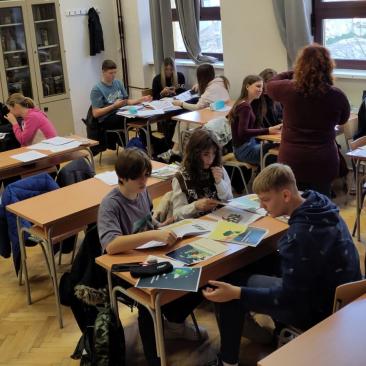
Partnering with Ana Fornažar, a Croatian forestry consultant with expertise in both forestry and pedagogy, and president of Istria Model Forest, FSC aimed to assess the reception, interactivity, and effectiveness of five newly developed educational modules on forests.
Evaluation Process
The evaluation took place in three first-year classes (ages 14–15), where a biology teacher introduced one of the modules in a 15–20-minute session. Following this, students received printed copies of all five modules to explore independently. The session concluded with both students and teachers completing a structured online survey to provide feedback on their preferences and suggestions for improvement.
Student Reactions
Students responded positively to the materials and offered insightful suggestions for improving accessibility and usability. Many appreciated how the modules connected forests to Croatia’s environment, making the topic more relatable. One student remarked, "I’ve never really thought much about forests. I guess it’s because there aren’t any nearby, but learning about them this way made me realize how important they are." Another added, "It’s exciting to learn something new about forests that we don’t typically cover in other subjects."
Teacher Feedback
Petra, a teacher from the coastal school in Pula, shared her thoughts:
"The new educational modules reflect our students' needs and interests. Teachers often struggle to find quality, accessible resources to educate students about climate change and the importance of natural resources. Initiatives like these are crucial in bridging that gap, providing environmental science materials in an engaging, student-friendly way."
Teachers also acknowledged the challenge of short attention spans, emphasizing the need for concise, visually appealing, and interactive educational materials. Their overall feedback was positive, noting that the modules successfully integrate multiple scientific disciplines. Some also suggested that the materials could benefit younger students as well, given the overlap in curriculum.
A key discussion point was the format of the materials. Many teachers expressed a preference for PowerPoint presentations, as they provide a more structured approach to lessons. Additionally, they recommended reaching out to the Provincial Association of High School Professors to explore integrating the modules into school programs.
What’s Next?
Based on the feedback collected, the project team focused on improving the format and accessibility of the forestry education modules. The first step was determining whether the materials should remain print-based, transition to an online format, or adopt a hybrid approach.
Additionally, dissemination and visibility remain key priorities. To ensure these valuable resources reach more educators and students, FSC is exploring various distribution channels, such as teacher Facebook groups, partnerships with environmental or pedagogic organisations, and direct outreach to schools via email.
Conclusion
These school visits provided invaluable insights that have shaped the refinement of our educational project in Croatia. Through active participation and meaningful feedback, we aim to develop a set of forestry education materials that could be adopted throughout the region—and beyond. This marks a small but significant step toward deepening students’ understanding of sustainable forestry and strengthening environmental education in schools.

